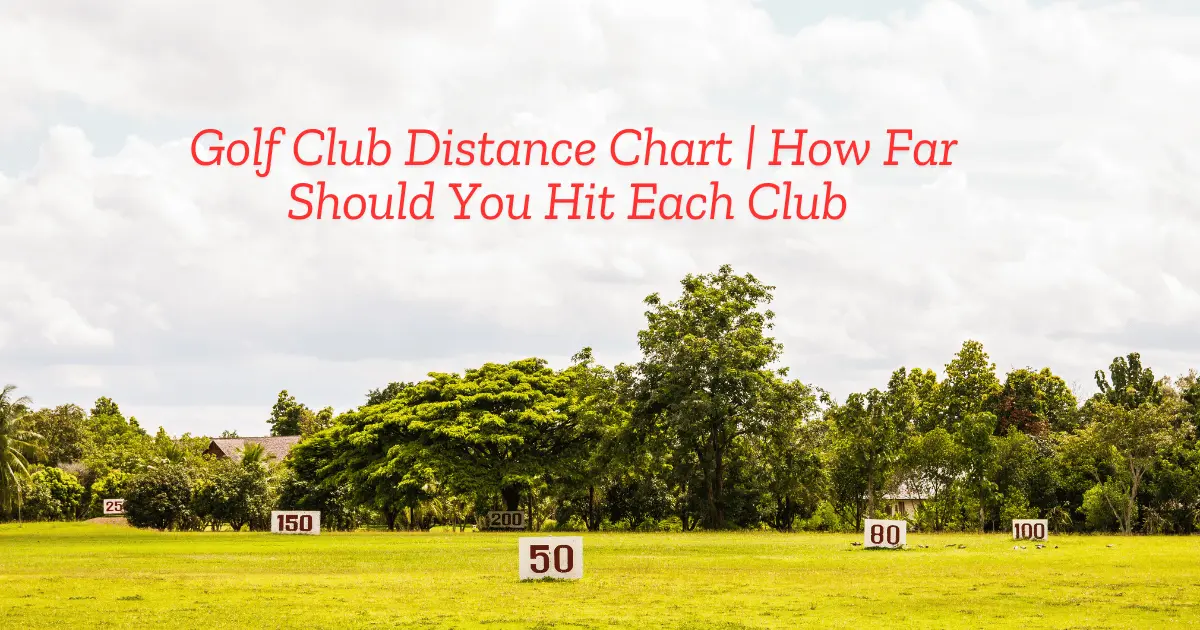If you’ve ever been playing golf and found yourself standing on the tee box wondering which club to use, don’t worry—you’re not alone. Golf is a game of lowering your score, and it’s very important to know how far you can hit with each club in your bag. That’s why using a golf club distance chart can be really helpful. Whether you’re a new player or have some experience, understanding your golf club distances is key to improving your game.
Are You Following Along?…..
I’ve done a lot of research on this topic to provide you with the simplest and clearest information. The distance chart I’ve created includes all the key factors that affect how far you can hit.
For example…
- Swing Speed: The faster you swing, the farther the ball will go.
- Ball Speed: How fast the ball moves is also important.
- Smash Factor: This shows how well the ball connects with the club.
- Equipment Quality: The quality of your clubs or balls also affects your game.
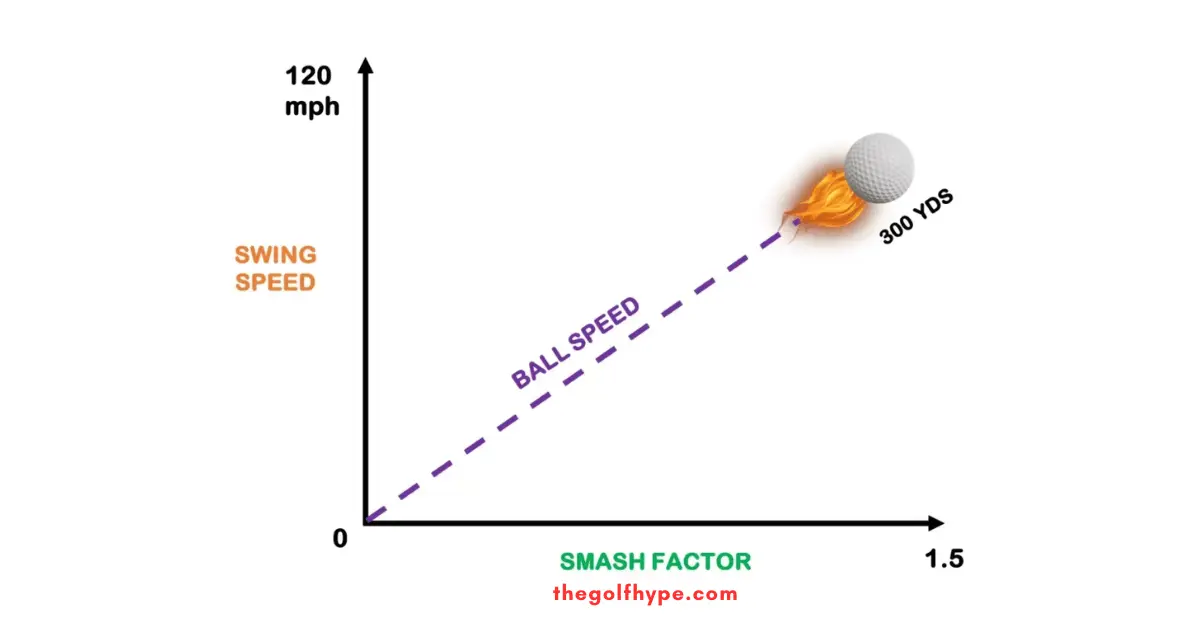
Here is, we’ll explain all the important things about golf distances in simple words. We’ll talk about how your swing speed, age, and skill level affect your game. By the end, you’ll understand how to use a distance chart to improve your score and hit more greens.
After learning all this, you’ll find that playing golf becomes even more enjoyable. And that’s our goal!
Golf Club Distance Chart by Swing Speed
When you play golf, your swing speed is very important. It determines how far you can hit the ball. Generally, as your swing speed increases, the ball goes farther. But that’s not everything. Just swinging fast is not enough.
For example, if a player swings their driver at 85 miles per hour, they can hit the ball about 200 yards. On the other hand, if a player swings at 100 miles per hour, they can easily reach 250 yards or more.
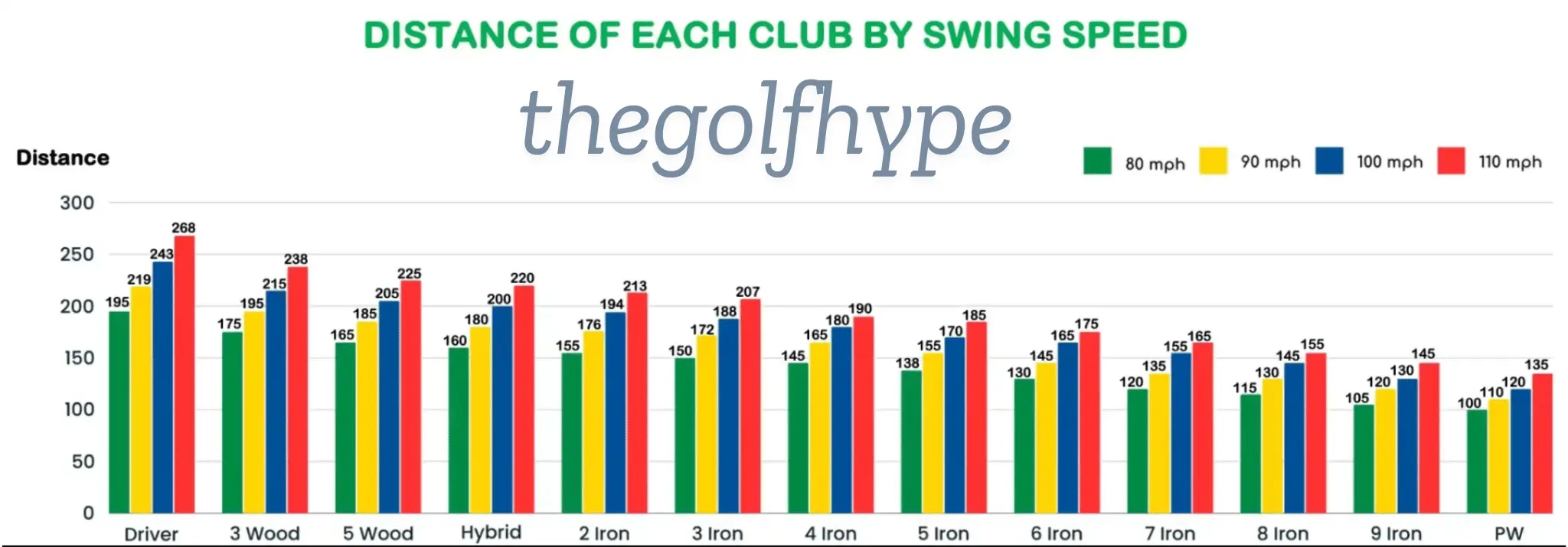
But what if your swing speed isn’t reaching where you want it to be? Maybe you need to work on your technique, or perhaps you need to learn how to use your club correctly. These things are all important and need to be considered.
| Club | 60 mph | 70 mph | 80 mph | 90 mph | 100 mph | 110 mph | 120 mph | 130 mph | 140 mph | 150 mph |
|---|---|---|---|---|---|---|---|---|---|---|
| Driver (Total) | 155 | 181 | 206 | 232 | 258 | 284 | 310 | 335 | 361 | 385 |
| Driver (Carry) | 146 | 170 | 195 | 219 | 243 | 268 | 292 | 316 | 340 | 365 |
| 3 Wood | 130 | 150 | 175 | 195 | 215 | 238 | 259 | 283 | 303 | 318 |
| 5 Wood | 125 | 145 | 165 | 185 | 205 | 225 | 245 | 265 | 285 | 305 |
| Hybrid | 120 | 140 | 160 | 180 | 200 | 220 | 240 | 260 | 280 | 300 |
| 2 Iron | 118 | 135 | 155 | 176 | 194 | 213 | 233 | 252 | 271 | 292 |
| 3 Iron | 115 | 130 | 150 | 172 | 188 | 207 | 226 | 245 | 265 | 284 |
| 4 Iron | 110 | 126 | 145 | 165 | 180 | 190 | 208 | 226 | 245 | 264 |
| 5 Iron | 105 | 120 | 138 | 155 | 170 | 185 | 198 | 215 | 228 | 247 |
| 6 Iron | 100 | 115 | 130 | 145 | 165 | 175 | 185 | 195 | 208 | 219 |
| 7 Iron | 95 | 105 | 120 | 135 | 155 | 165 | 175 | 185 | 195 | 210 |
| 8 Iron | 85 | 100 | 115 | 130 | 145 | 155 | 165 | 175 | 190 | 202 |
| 9 Iron | 80 | 90 | 105 | 120 | 130 | 145 | 160 | 175 | 186 | 197 |
| Pitching Wedge | 73 | 85 | 100 | 110 | 120 | 135 | 145 | 156 | 167 | 179 |
So, if you want to improve in golf, don’t just try to swing faster. Improve your movement, and use your swing speed correctly. This way, you can get better results.
How Do I Swing the Club Faster?
You might have seen the numbers on your comparison chart, but you want to improve them. Everyone does, and here are 3 easy ways to swing your golf club faster:
1. Learn the correct technique with a professional coach:
If you learn the right way with the help of a professional swing coach, they will help you make the most of your physical strength and limits. With their guidance, you’ll find it easier to hit the ball from the correct spot on the club. Using the right technique, you can increase your driver’s swing speed by up to 10 miles per hour.
2. Build strength and flexibility in the gym:
If you want to make your body stronger and more active, it’s important to work on both strength and flexibility. Do the right exercises with a trainer to help increase your swing speed. When your muscles become more flexible and your strength improves, you can increase your swing speed by 10-20 miles per hour. This increase depends on your current strength and flexibility.
3. Use lighter golf equipment:
If you replace your club’s shaft with a lighter one, it can increase your swing speed by 2-5 miles per hour. This is a simple change that can help improve your speed.
The most important thing….
There are many ways to improve your swing speed, but the most important thing is to take coaching and practice regularly. This is what will help you master hitting the ball from the correct spot on the club. When you hit the ball from the right spot, it will transfer the most energy and give you the best results.
All these tips are designed to bring you more joy and success in playing golf. So, start comfortably and gradually improve your skills!
What is Smash Factor?
Smash factor is a term you’ll often hear in golf discussions, especially when talking about distance. Simply put, it’s the ratio of ball speed to clubhead speed. A higher smash factor means you’re transferring energy more efficiently from the club to the ball.
For case 150 mph ball speed / 100 mph swing speed = 1.50 Smash Factor
Ideal Smash Factor for Every Club
The ideal smash factor varies by club. For drivers, a smash factor of 1.48 to 1.50 is considered excellent. For irons, it’s typically lower, around 1.38 to 1.42. Knowing your smash factor can help you identify areas for improvement in your swing.
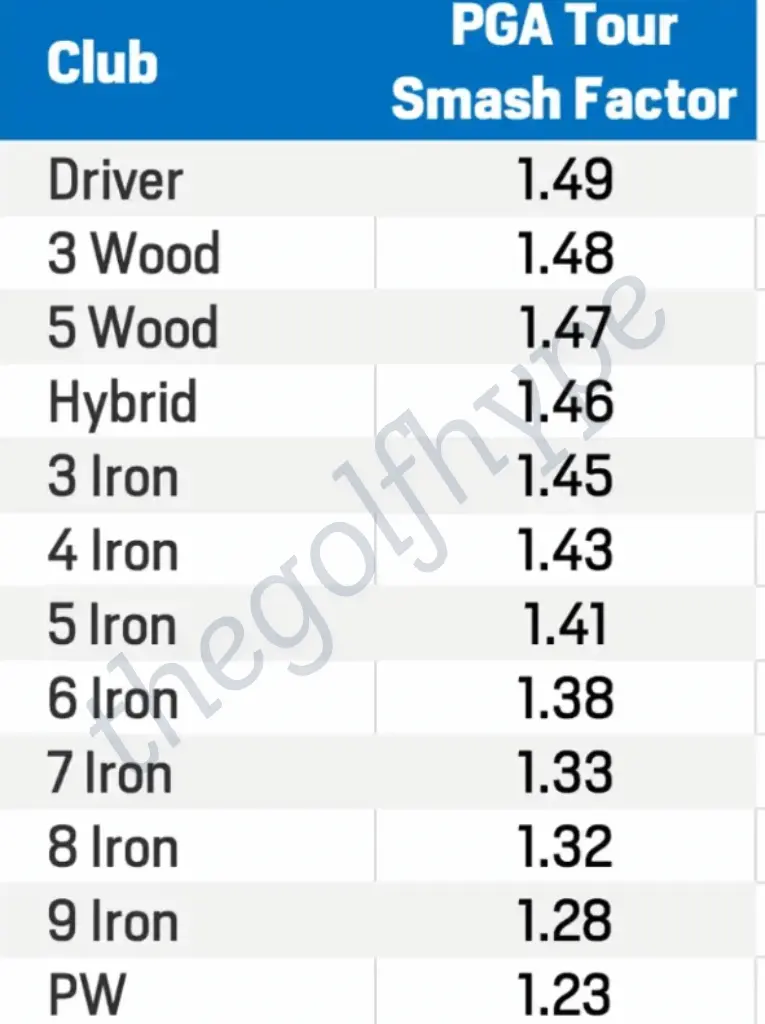
Skill Level Affects Smash Factor
In golf, when you hit the ball, it greatly depends on how your club makes contact with the ball. Even the speed of your swing depends on which part of the club you hit the ball with. If you hit the ball with the center or near the center of the club, your power will transfer to the ball more effectively.
This means that when your club hits the ball at the right spot, the benefit of your swing speed will be used more efficiently. This way, your shots will be more powerful and go farther. If you have a coach, they will teach you how to hit the ball with the center or near the center of the club so that your current swing can be used in the best way.
We call this measure the Smash Factor. It is a number that tells how much of your swing speed is transferred to the ball. It’s very simple to understand: the higher your Smash Factor, the better your shot will be.
Just remember that you need to hit the ball with the right part of the club on every shot. This will not only improve your shots but also give you more control over your game.
Equipment Affects Swing Speed and Smash Factor
Professional golfers who play on tours have improved their equipment based on their special skills, physical strength, and body shape. Their technique is very refined, so even if you and they hit the same type of ball, their ball will still travel farther than yours. Their equipment is designed to match their unique swing, allowing them to hit the ball over greater distances.
Similarly, even if an average amateur golfer has the same swing speed, they will still fall behind compared to a professional. This is all possible because of the professional’s better technique and the right equipment.
If you adjust your golf equipment to match your strength and body shape, it can help increase your power and allow you to hit the ball farther. This way, you can also improve your game.
How to Use a Golf Club Distance Chart to Improve Your Game
A golf club distance chart is more than just a list of numbers—it’s a tool to help you make smarter decisions on the course. Start by tracking your distances during practice sessions using a launch monitor or GPS device. Once you have your averages, compare them to a standard golf club yardage chart to see where you stand.
For example, if your 7-iron consistently goes 140 yards but the chart suggests it should be closer to 150, you might need to work on your swing speed or ball striking.
Average Golf Club Distances for Men, Women, and Seniors
Distance varies significantly based on factors like age, gender, and skill level. Here’s a quick breakdown:
- Men: Average driver distance is around 230 yards, with a 7-iron typically traveling 140-160 yards.
- Women: Average driver distance is about 180 yards, with a 7-iron averaging 120-140 yards.
- Seniors: Distance tends to decrease with age, with senior men averaging 200 yards with a driver and 130 yards with a 7-iron.
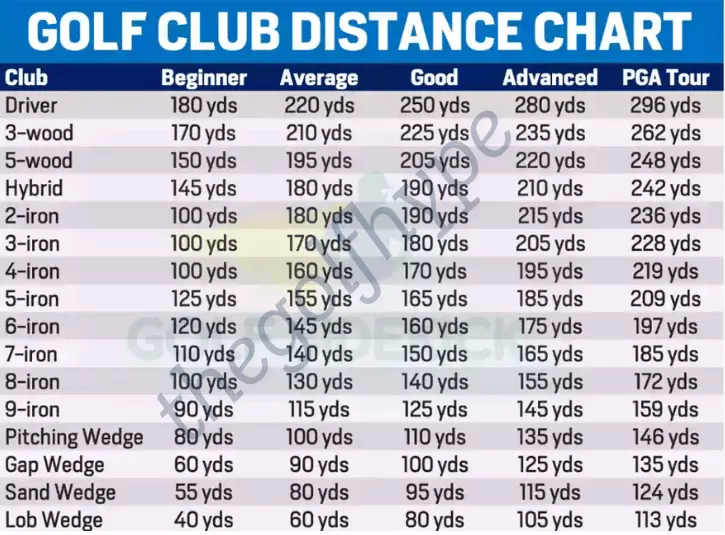
Swing Speed Charts by Age and Gender
A great way to play good golf is to understand how important your swing speed and the point where you hit the ball are. When you hit the ball with the center of the clubface, it can go much farther. Even if your swing is fast, if you hit the ball in the wrong spot, it won’t go very far.
If two different players, one professional and one amateur, hit the ball at the same speed, the professional’s ball will still go farther. This is because the professional always tries to hit the ball with the center of the club.
So, if you want to improve your distance, you need to make sure your club is hitting the ball in the right spot. This way, even with the same speed, your ball will go much farther.
Remember, in golf, just power or speed isn’t enough. Hitting the ball in the right spot is just as important!
Average Swing Speed by Age and Gender Chart
- Men (20-30 years): 100-110 mph
- Women (20-30 years): 75-85 mph
- Seniors (60+ years): 75-90 mph
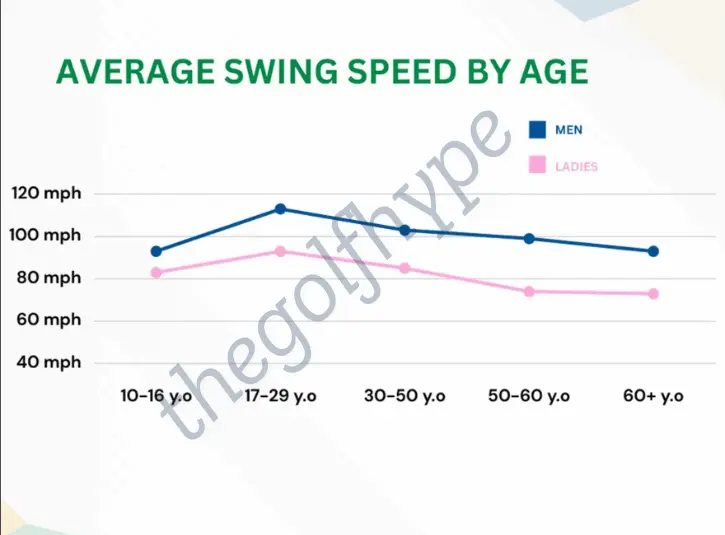
| Age | Men | Women |
| 10-16 years old | 93 mph | 83 mph |
| 17-29 years old | 113 mph | 93 mph |
| 30-50 years old | 103 mph | 85 mph |
| 50-60 years old | 99 mph | 74 mph |
| 60+ years old | 93 mph | 73 mph |
Driver Swing Speed Chart by Golf Skill Level
Playing golf with a driver depends a lot on a person’s skill and confidence. Beginners usually have a less stable technique and are less effective in taking strokes. They are still gaining experience and have not yet fully mastered all the aspects of the game.
On the other hand, intermediate players, who have been learning the game for some time or have taken lessons from professionals, show improvement in their skills. They are more confident in their strokes and their movements are more solid.
Expert players, like those on the PGA Tour, have complete control over every aspect of the game. They have the best techniques and perform excellently under any condition. They have reached the highest standards of the game and there is no other player quite like them.
It is important to understand that every player has their own limits, but with lessons and practice, any player’s skills can improve.
| Skill Level | Swing Speed | Driver Distance |
| Beginner | 80 mph | 190 yards |
| Average | 94 mph | 220 yards |
| Good | 100 mph | 240 yards |
| Excellent | 110 mph | 265 yards |
| PGA Tour Average | 114 mph | 275 yards |
| Women’s Average | 77 mph | 180 yards |
| LPGA Tour Average | 94 mph | 218 yards |
Is a 250-Yard Drive Good?
Absolutely! A 250-yard drive is well above average for most amateur golfers. Achieving this distance usually requires a swing speed of around 100 mph and solid contact.
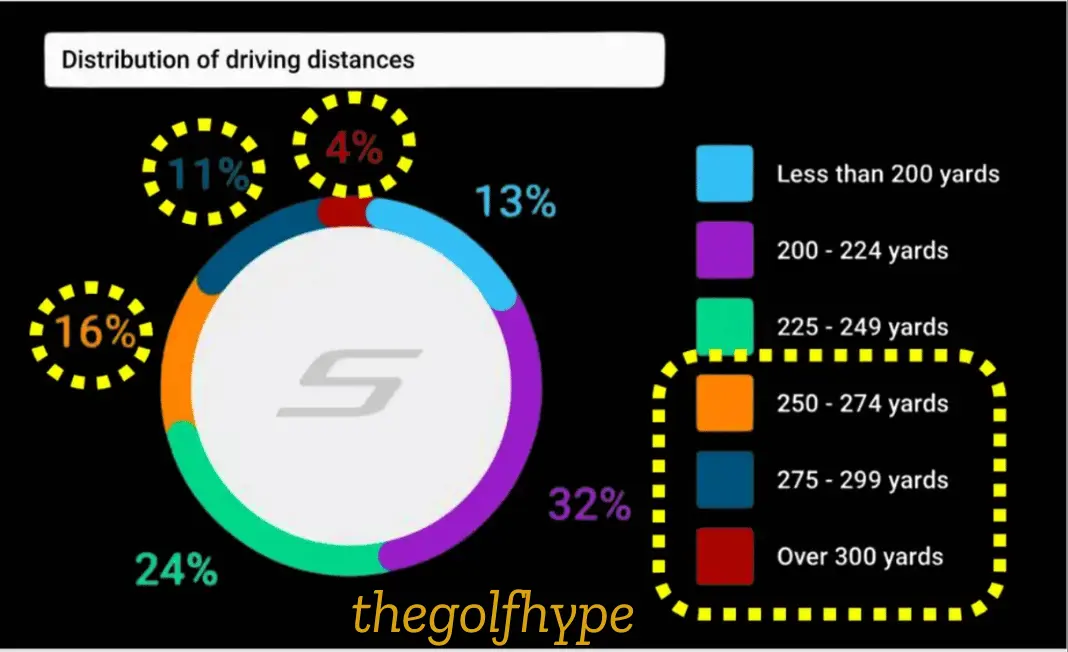
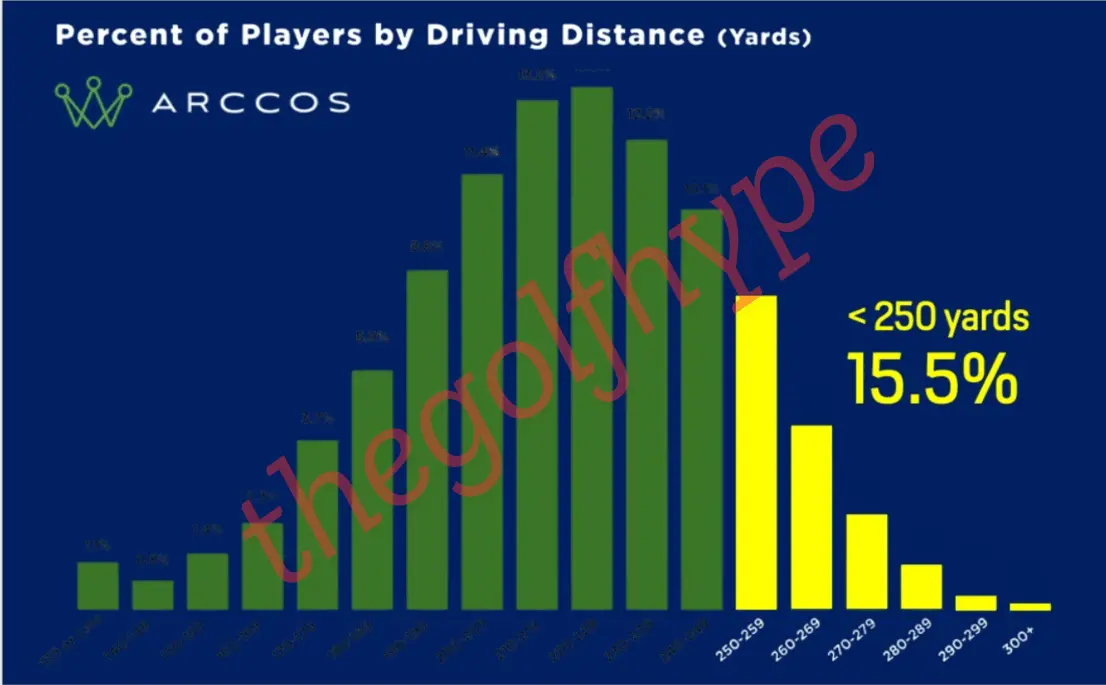
Ball Speed to Club Head Speed Chart for Driver
If we translate the technical terms into simple words, it means that when you hit the ball, its speed depends on your strike. If you hit the ball correctly, it will come out with force, but if the strike is weak or incorrect, the ball’s speed will also be less.
Usually, when we estimate the speed of a golf club, we also consider how well you have hit the ball. If your smash factor (i.e., the correct way of hitting the ball) is around 1.42, then it is close to the best strike. This will make the ball come out faster. But if your strike is weak, the ball’s speed will be affected.
This means that to hit the ball with force, you need to correct your movement. This way, your ball can go farther.
| Ball Speed (mph) | 110 | 120 | 130 | 140 | 150 | 160 | 170 | 180 | 190 | 200 |
| Club Head Speed (mph) | 77 | 84 | 91 | 98 | 104 | 111 | 118 | 125 | 132 | 138 |
| Driver Carry | 181 | 198 | 214 | 231 | 247 | 263 | 280 | 296 | 313 | 329 |
What Swing Speed Hits 250-Yard Drives?
As mentioned earlier, a swing speed of around 100 mph is typically needed to achieve a 250-yard drive, assuming solid contact and optimal launch conditions.
Ball Speed to Club Head Speed for 7 Iron
Have you ever wondered how far you can hit with your 7 iron in golf? It depends on different factors, such as your swing speed and the smash factor. The smash factor means how effectively your club transfers energy to the ball when it hits it.
Usually, the average smash factor for a 7 iron is 1.33. But if you use a driver, this number increases to around 1.50. These numbers are based on the average of PGA Tour players.
When you use different clubs on the course, remember that smaller clubs can change the ball speed and energy transfer. This is important because as the length of the club decreases, the way you use it also changes.
If you know your swing speed, you can estimate how far you can hit with a 7 iron. It all depends on your training and experience too. So, if you find it hard to understand what all these numbers mean, just remember this: a higher swing speed will give you more distance, and each club has its own special role.
This will make playing golf even more fun for you!
7 Iron Distance By Driver Swing Speed
| Swing speed | Distance |
| 60 mph | 95 yards |
| 70 mph | 105 yards |
| 80 mph | 120 yards |
| 90 mph | 135 yards |
| 100 mph | 155 yards |
| 110 mph | 165 yards |
| 120 mph | 175 yards |
| 130 mph | 185 yards |
| 140 mph | 195 yards |
| 150 mph | 210 yards |
What Swing Speed Hits the 7 Iron 150 Yards?
A swing speed of 75 mph is usually enough to hit a 7-iron 150 yards, as long as you hit the ball well.
Golf Club Distance Charts: Other Important Factors
While swing speed and smash factor are critical, other factors like loft, weather conditions, and even your physical fitness can impact your distances.
Loft
Every golf club has its own shape and features, designed to cover different distances. Generally, a club with more “loft” (the angle of the club’s head) covers a shorter distance. On the other hand, clubs with less loft and longer shafts help you cover more distance.
The driver (considered the longest golf club) is usually used to hit the ball the farthest. In contrast, clubs like the “lob wedge” have more loft, which means they cover less distance.
Nowadays, golf clubs have seen a lot of improvements. Modern club makers have reduced the loft, giving them the ability to cover more distance. Today, the loft of each club ranges between 2 to 5 degrees, which automatically increases the distance compared to older clubs. A good thing is that you can now cover up to 15 yards more. However, remember that the driver’s loft cannot be too low because you would need to swing very fast to hit the ball. If your swing speed is slow, it will be difficult to use low-lofted clubs properly.
| Clubs | Average Lofts 2022 | Average Lofts 1990 |
| Driver | 8° – 13° | 9° – 14° |
| 3 Wood | 13° – 15° | 15° – 17° |
| 5 Wood | 20° – 23° | 21° – 24° |
| 2 Iron | 18° – 20° | 20° – 22° |
| 3 Iron | 21° – 24° | 23° – 25° |
| 4 iron | 25° – 28° | 28° – 30° |
| 5 iron | 28° – 31° | 31° – 33° |
| 6 iron | 32° – 35° | 35° – 37° |
| 7 iron | 36° – 38° | 39° – 41° |
| 8 iron | 40° – 43° | 43° – 47° |
| 9 iron | 45° – 48° | 48° – 50° |
| Pitching Wedge | 47° – 50° | 51° – 54° |
Additionally, new golf clubs use better materials, making them more reliable and easier to use. Modern club shafts are very light, which increases the ball’s speed. This is especially helpful when you are playing on the fairway.
Finally, remember that choosing the right club is very important. If your swing speed is slow, it might be difficult to use low-lofted clubs. That’s why most people use fairway woods, which have a loft of no more than 16 or 17 degrees. These help you cover a suitable distance.
In this way, playing with modern golf clubs has become easier and more enjoyable. If you want to understand more about golf, it can be very useful to learn about the nature of the club shafts and their flex.
Golf Club Distance Charts of PGA Tour Golfers
PGA Tour players are in a league of their own when it comes to distance. The average driver distance on tour is around 295 yards, with 7-irons traveling 170-180 yards.
| Club | PGA TOUR Average Distance (yards) | Bryson De Chambeau | Dustin Johnson | Rory McIlroy | Tiger Woods | Jack Nicklaus | LPGA Tour Averages |
| Driver | 275 | 325 | 312 | 360 | 297 | 250 | 255 |
| 3 Wood | 243 | 295 | 282 | 325 | 265 | 235 | 230 |
| 5 Wood | 230 | 275 | 267 | 300 | 245 | 220 | 215 |
| 3 Iron | 212 | – | – | – | 227 | 210 | 197 |
| 4 Iron | 203 | 255 | 236 | 272 | 215 | 195 | 186 |
| 5 Iron | 194 | 235 | 225 | 256 | 200 | 180 | 175 |
| 6 Iron | 183 | 220 | 212 | 235 | 186 | 167 | 164 |
| 7 Iron | 172 | 205 | 200 | 222 | 170 | 155 | 153 |
| 8 Iron | 160 | 190 | 186 | 200 | 157 | 145 | 142 |
| 9 Iron | 148 | 175 | 172 | 188 | 148 | 130 | 130 |
| Pitching Wedge | 136 | 160 | 158 | 169 | 136 | 120 | 118 |
Why Are Modern Golfers Longer Than Prior Generations?
Modern golfers are hitting the ball farther than ever before, and there are many reasons for this….
Physical Fitness
Most new professional golfers often work out in gyms during the week, and most are also easily accessible in physio offices. In the old days, for example, during the time of Arnold Palmer and Jack Nicklaus, professionals usually worked under regular guidance. Back then, it was common for them to smoke cigarettes on the course and have drinks, but now all those behaviors have changed.
For example, Bryson DeChambeau is someone who bulked up to make himself stronger, meaning he increased his body size to boost natural strength. The impact on his game was very clear. Although he has slowed down again now, the effects of his work are still being discussed.
When Tiger Woods started working out in gyms in the modern era, he brought a huge change. He was in strong physical condition, which took his game to a new level. This inspired a new generation of golfers, who are still hitting the ball with similar strength and energy.
In this way, modern professional golfers have not only increased their physical strength but also created a new culture on the golf course as a result.
Club Advancements
Golf clubs have seen many changes that help players improve their game. In the past, clubs had more loft (lifting), but now new irons come with less loft, which allows the ball to travel farther. For example, in the 1980s, a 7-iron had a loft angle of 40 degrees, but now it is only 28 degrees. This 12-degree difference allows the ball to travel 20-30 yards farther.
Additionally, the materials used in clubs have also changed significantly. Old clubs were made of heavy steel or wood, but now drivers are made of lightweight materials like titanium and carbon. Their shafts are also made of graphite, which helps players hit the ball farther.
When we compare old clubs to new ones, it is clear how much easier and more effective the new clubs are. Old clubs were heavy and difficult to use, while new clubs are lighter and more user-friendly. These changes not only make the game easier but also help players achieve better results.
In this way, the evolution of golf clubs has made the game more exciting and accessible.…
Golf Ball
When the Pro V1 golf ball was released, it brought a huge change to the game of golf. The new balls travel much farther than the old ones. They have the ability to fly straighter and spin less. Now, the balls have become so powerful that golf’s governing bodies are concerned they might have to make the ball smaller to keep golf courses safe.
If professional players use this new ball to hit long shots, golf courses will need to be made longer. However, this is also a problem because there is only a limited amount of money available for land.
Additionally, the Balata golf ball, which is significantly smaller than the current solid-core balls covered with urethane, is different in style from the balls used on the tour. Using this smaller ball will present players with new types of challenges.
All these changes are shaping the world of golf in a new way and creating a new challenge for players.
Final Thought of Golf Club Distances Chart
Understanding your golf club distance chart is very important if you want to get better at golf. By keeping track of how far you hit with each club, improving your swing speed, and using the right clubs, you can really improve your game.
So, next time you’re playing, use your golf club yardage chart to make better and more confident choices. Your scorecard will show the improvement!

